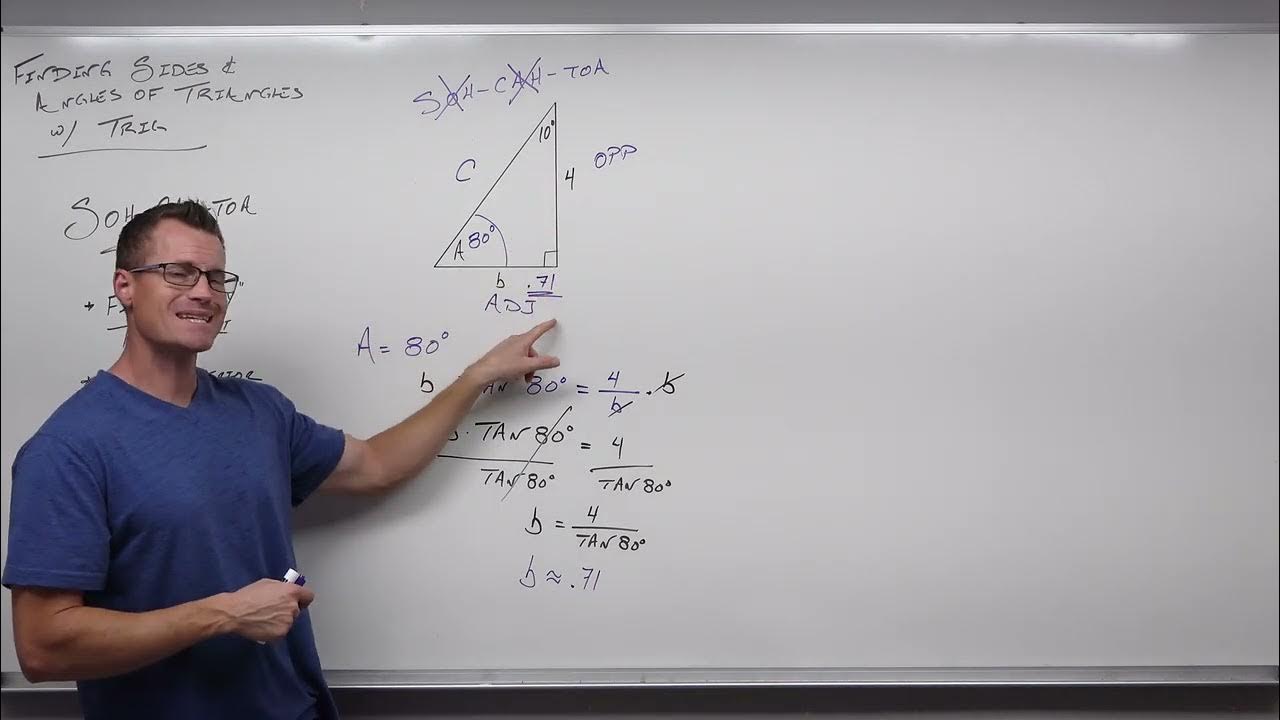Trigonometry Missing Sides - Corbettmaths
TLDRThis video tutorial delves into the application of trigonometry for determining missing sides of right-angled triangles. By leveraging the trigonometric ratios of tangent, sine, and cosine, the video demonstrates step-by-step solutions to various problems, including how to label triangle sides and apply the appropriate ratios to find the unknown lengths. The examples provided cover a range of scenarios, effectively illustrating the process of substituting known values into the trigonometric equations and solving for the variables, ultimately enhancing the viewer's understanding of trigonometry in practical problem-solving.
Takeaways
- 📚 Trigonometry is used to find missing sides of right-angled triangles when given an angle and one side.
- 📐 The three primary trigonometric ratios are: tangent (tan), sine (sin), and cosine (cos).
- 🔢 For a right-angled triangle, tan(θ) = opposite/adjacent, sin(θ) = opposite/hypotenuse, and cos(θ) = adjacent/hypotenuse.
- 🎓 Before solving problems, it's recommended to watch an introduction to trigonometry video for better understanding.
- 🖌️ Label the sides of the triangle correctly: opposite, adjacent, and hypotenuse based on the given angle and sides.
- 🧩 Use the appropriate trigonometric ratio based on the given information and the side you wish to find.
- 🔢 For example, if given an angle and the adjacent side, use the tangent ratio to find the opposite side.
- 📐 When solving equations, aim to isolate the variable (e.g., x) by performing algebraic operations like multiplication or division.
- 📊 Use a calculator to find the value of the trigonometric function (e.g., tan, sin, cos) for a specific angle.
- 📝 Round the final answer to the desired decimal places, often two decimal places for precision.
- 💡 This video provided practical examples of using trigonometry to solve for missing sides in right-angled triangles, demonstrating the process step by step.
Q & A
What is the main topic of the video?
-The main topic of the video is using trigonometry to find the lengths of missing sides in right-angled triangles.
What are the trigonometric ratios discussed in the video?
-The trigonometric ratios discussed are tangent (tan), sine (sin), and cosine (cos).
How is the tangent ratio defined in the context of a right-angled triangle?
-The tangent ratio is defined as the opposite side divided by the adjacent side.
What is the sine ratio used for in a right-angled triangle?
-The sine ratio is used to find the length of the opposite side when given the angle and the hypotenuse.
How is the cosine ratio defined in the context of a right-angled triangle?
-The cosine ratio is defined as the adjacent side divided by the hypotenuse.
What is the first example problem presented in the video?
-The first example problem involves a right-angled triangle with a 63-degree angle, a 7 cm side, and the goal is to find the length of the opposite side.
How does the video demonstrate solving for the missing side in the first example?
-The video demonstrates solving for the missing side by using the tangent ratio, substituting known values, and solving the resulting equation.
What is the second example problem presented in the video?
-The second example problem involves a right-angled triangle with a 41-degree angle, a 3 cm side, and the goal is to find the length of the hypotenuse.
How does the video solve for the hypotenuse in the second example?
-The video solves for the hypotenuse by using the sine ratio, substituting known values, and solving the resulting equation.
What is the third example problem discussed in the video?
-The third example problem involves a right-angled triangle with a 52-degree angle, a 14 cm side, and the goal is to find the length of the adjacent side.
How does the video solve for the adjacent side in the third example?
-The video solves for the adjacent side by using the cosine ratio, substituting known values, and solving the resulting equation.
What is the final example problem in the video about?
-The final example problem involves a right-angled triangle with a 58-degree angle and a 6-meter side, and the goal is to find the length of the adjacent side.
How is the length of the adjacent side found in the final example?
-The length of the adjacent side is found by using the tangent ratio, substituting known values, and solving the resulting equation.
Outlines
📚 Introduction to Trigonometry and Finding Missing Sides
This paragraph introduces the concept of using trigonometry to find the lengths of missing sides in a right-angled triangle. It emphasizes the importance of understanding the basics, such as labeling the sides and knowing the trigonometric ratios (tan, sin, cos). The video provides an example with a 63-degree angle and a known side length of 7 cm, aiming to find the length of the opposite side. The process involves identifying the correct trigonometric ratio (tan in this case), setting up the equation, and solving for the unknown side length (X), which is found to be 13.74 cm.
📐 Solving for the Hypotenuse Using Trigonometric Ratios
The second paragraph focuses on solving for the hypotenuse of a right-angled triangle when given an angle and the length of the opposite side. The example uses a 41-degree angle and a 3 cm opposite side to find the hypotenuse (X). The sine function is selected as the appropriate trigonometric ratio, and the equation is set up accordingly. By multiplying both sides of the equation by the hypotenuse (X) and solving for X, the hypotenuse is determined to be 4.57 cm. This section reinforces the method of applying trigonometry to real-world problems involving right-angled triangles.
🔍 Applying Trigonometry to Find the Adjacent Side
This paragraph demonstrates how to find the length of the adjacent side in a right-angled triangle when given the hypotenuse and an angle. The example involves a 52-degree angle, a 14 cm hypotenuse, and an unknown adjacent side (X). The cosine function is used to set up the equation, and by multiplying both sides by the hypotenuse and solving for X, the adjacent side is calculated to be 8.62 cm. The explanation is clear and methodical, showing the step-by-step process of using trigonometry to solve for missing sides in a right-angled triangle.
📝 Calculating the Length of a Missing Side in a Given Triangle
The final paragraph presents a scenario where the length of side AC (X) needs to be calculated in a right-angled triangle with a 58-degree angle, a 6-meter opposite side, and an adjacent side of unknown length. The tangent function is the chosen trigonometric ratio for this problem. By setting up and solving the equation, the length of the adjacent side (AC) is determined to be 3.75 meters. This section concludes the video by summarizing the practical application of trigonometry in finding missing sides of right-angled triangles, encouraging viewers to apply these concepts to solve similar problems.
Mindmap
Keywords
💡Trigonometry
💡Right-Angle Triangle
💡Trigonometric Ratios
💡Hypotenuse
💡Opposite Side
💡Adjacent Side
💡Angle
💡Pythagorean Theorem
💡Sine (sin)
💡Cosine (cos)
💡Tangent (tan)
Highlights
The video introduces the use of trigonometry to find missing sides of right angle triangles.
Trigonometric ratios are defined: tan(θ) = opposite/adjacent, sin(θ) = opposite/hypotenuse, cos(θ) = adjacent/hypotenuse.
A right angle triangle example is presented with a 63-degree angle and a 7 cm side, aiming to find the missing side length.
The process of using the tangent ratio to solve for the missing side length is demonstrated step by step.
The calculation results in a missing side length of 13.74 cm using the tangent ratio for the 63-degree triangle.
A second example is given with a 41-degree angle and a 3 cm side, focusing on finding the hypotenuse.
The sine ratio is applied to find the hypotenuse, resulting in a length of 4.57 cm.
The third example involves a 52-degree angle, a 14 cm side, and the calculation of the adjacent side using the cosine ratio.
The adjacent side is found to be 8.62 cm, illustrating the practical use of the cosine ratio in trigonometry.
The final example calculates the length of side AC in a right angle triangle with a 58-degree angle and a 6 m side.
Using the tangent ratio again, the length of side AC is determined to be 3.75 meters.
The video emphasizes the importance of using the correct trigonometric ratio based on the given information.
Trigonometry is shown to be a powerful tool for solving real-world problems involving right angle triangles.
The video provides a clear and methodical approach to solving trigonometry problems, making it accessible to learners.
Each step in the calculations is explained, ensuring that viewers understand the process and not just the final answer.
The video concludes by reinforcing the utility of trigonometry in finding missing sides of right angle triangles.
The presenter encourages viewers to like and subscribe for more educational content on trigonometry and other mathematical topics.
Transcripts
Browse More Related Video

How To Solve Two Triangle Trigonometry Problems

Finding Sides and Angles with Right Triangle Trigonometry (Precalculus - Trigonometry 31)

Trigonometry: Finding missing sides and angles

Trigonometry For Beginners!

LEPT Math Majorship 2024 | Trigonometry Calculator Techniques

Introduction to Right Triangle Trigonometry (Precalculus - Trigonometry 30)
5.0 / 5 (0 votes)
Thanks for rating: